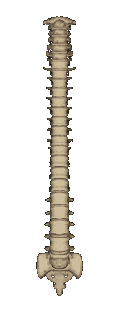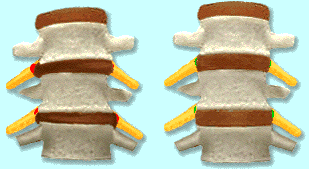Chiropractic

Chiropractic is a healing arts which is based upon the understanding that good health depends, in part, upon a normally functioning nervous system (especially the spine, and the nerves extending from the spine to all parts of the body).
“Chiropractic” comes from the Greek word Chiropraktikos, meaning “effective treatment by hand.” Chiropractic stresses the idea that the cause of many disease processes begins with the body’s inability to adapt to its environment. It looks to address these diseases not by the use of drugs and chemicals, but by locating and adjusting vertebraes of the spine which is functioning improperly. The conditions which doctors of chiropractic address are as varied and as vast as the nervous system itself.
Chiropractors use a standard procedure of examination to diagnose a patient’s condition and arrive at a course of treatment. Doctors of chiropractic use the same time-honored methods of consultation, case history, physical examination, laboratory analysis and x-ray examination as any other doctor.
The examination of the spine to evaluate structure and function is what makes chiropractic different from other health care procedures. Your spinal column is a series of movable bones which begin at the base of your skull and end in the center of your hips. Thirty-one pairs of spinal nerves extend down the spine from the brain and exit through a series of openings. The nerves leave the spine and form a complicated network which influences every living tissue in your body.
In the simplest of terms, a subluxation (a.k.a. Vertebral Subluxation) is when one or more of the bones of your spine (vertebrae) move out of position and create pressure on, or irritate spinal nerves. Spinal nerves are the nerves that come out from between each of the bones in your spine. This pressure or irritation on the nerves then causes those nerves to malfunction and interfere with the signals traveling over those nerves. Good health depends, in part, on the normal alignment of the body’s parts, and this subluxation or misalignment can be a major factor in illness. These disturbances may irritate nerve roots and the blood vessels which branch off from the spinal cord between each of the vertebrae. This irritation may cause pain and dysfunction in muscle, lymphatic and organ tissue, as well as neurologic imbalance in the normal body processes.
How does this affect you? Proper alignment of the spine is critically important because of its central role in the nervous system’s function. Your nervous system controls and coordinates all of the functions in your body. If you interfere with the signals traveling over nerves, parts of your body will not get the proper nerve messages and will not be able to function at 100% of their innate abilities. In other words, some parts of your body will not be working properly.
The word “subluxation” comes from the Latin words meaning “to dislocate” (luxare) and “somewhat or slightly” (sub). A subluxation means a slight dislocation (misalignment) or biomechanical malfunctioning of the vertebrae (the bones of the spine).


A fall, injury, sudden jar, trauma, or sometimes an inherited spinal weakness can displace a vertebra. Other causes include improper sleeping conditions or habits, poor posture, occupational hazards, incorrect lifting practices, obesity, lack of rest and exercise, and stress.
causes
Doctors of Chiropractic are specialists in neuromusculoskeletal conditions. They are trained to restore the misaligned vertebrae to their proper position in the spinal column. They do this manually, utilizing the chiropractic procedure known as “spinal adjustment”. Your chiropractor, in most cases, will use his or her hands in applying corrective pressure to the spine in a specific direction and location. The manual force or thrust helps restore the alignment and mobility of the vertebrae. In some cases, the chiropractor may use instrumentation to detect subluxations and adjust the spine.
Under normal circumstances, chiropractic adjustments are painless. In cases of recent trauma, such as whiplash, mild discomfort may be experienced due to inflammation. It is also common to feel a brief sensation in the extremities immediately following an adjustment due to the sudden decompression of the affected nerve root.
Chiropractic adjustments help eliminate imbalances or disruptions in the body so that it can function at its true potential. When any of the 24 movable spinal vertebrae become misaligned, a basic imbalance or disruption occur in the nervous system which contribute to stress in the body, and or “dis-ease”.
Regular chiropractic care may be necessary to correct spinal subluxations to help maintain sound health and fitness. Your spine is under constant strain during waking hours. Improper lifting techniques, poor posture, accidents, falls and bumps, and other causes can contribute to spinal strain. Timely adjustments can help restore the neuromusculoskeletal integrity of the spine to normalize the bodily equilibrium and increase resistance.
Chiropractic patients range in years from birth to old age. Regardless of age, the vertebrae can become misaligned. For example, the birth process may cause trauma to the neck and spine. Left uncorrected, the vertebral subluxation may disturb the delicate spinal cord and nerves which control the youngster’s muscles and organs. In some cases, an uncorrected subluxation may lead to a deformity of the spinal column. An early chiropractic checkup may detect many spinal problems while they are still easily correctable.
No, it is a common misconception that your joints must make a noise to be properly adjusted. However, more often than not when your vertebrae are adjusted, the smooth articular (joint) surfaces become separated, creating and then releasing a small vacuum, making a noise. This is the sound made when you adjust your knuckles. Your chiropractor is concerned with the position of your vertebrae, not with the noise that may occur.
Even if you feel fine, chiropractic care can help your body maintain its required level of health and fitness. Your chiropractor can recommend a preventive spinal-care program and advise you on correct posture, dietary information and back exercises. Regular spinal checkups can help detect and prevent spinal stress due to subluxations.
Yes. Chiropractors do not include medication or surgery in their treatment program. Chiropractors maintain that the body has a built-in capacity to restore health within certain limits, and base their care on this principle. Occasionally, the use of medication can interfere with the body’s healing mechanisms, produce side effects, create a dependence and lead to drug-caused disease or complications. The first response in most illnesses and injuries should be conservative care. Chiropractic’s principles make it possibly the safest and most appealing of the healing arts.
Because of the additional weight and stress on the framework of the body in pregnant women, chiropractic adjustments can help lower the incidence of pain in the low back and legs, and between the shoulder blades. In some cases, fewer headaches and problems with nausea and elimination may also result. Many chiropractors care for expectant mothers in the regular course of their daily practices. It is wise, however, to first inquire about the experience of your chiropractor in caring for pregnant women and what he or she recommends for you.
Please watch this informative video describing subluxation and how it effects the function of the body and how Chiropractic adjustments corrects the subluxation.
Chiropractic teaches that reducing or eliminating this irritation to spinal nerves can cause your body to operate more efficiently and more comfortably. Chiropractic also places an emphasis on nutritional and exercise programs, wellness and lifestyle modifications for promoting physical and mental health, when those interventions are indicated.

